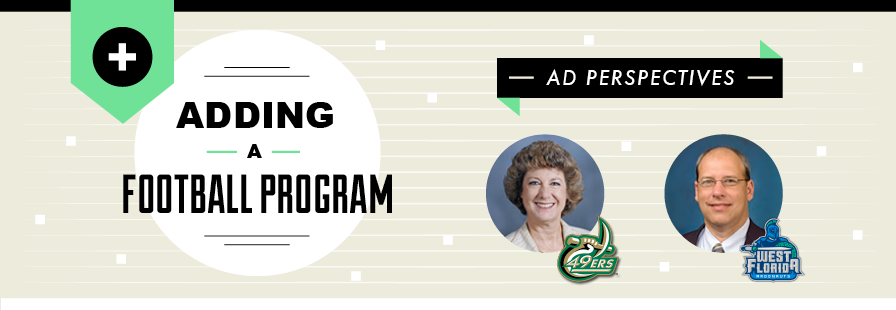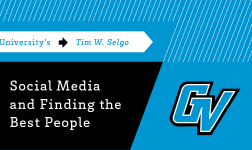The long-term considerations faced by an athletic department looking to add football, from a tactical standpoint, are myriad and complex. It is a process that involves years of careful planning in regard to NCAA regulations, as well as diligent fund raising, and forward-thinking facilities management and preparation for new construction or upgrades. How to make sound institutional decisions and overcome fiscal challenges, incur as few surprises as possible, while being inclusive of faculty, staff, and student sentiment would be daunting for even the most seasoned administrator. We wanted to know more about how these difficult determinations were arrived at—what qualitative and quantitative factors are involved in the addition of football?
Two ADs—one D-I, the other D-II—were good enough to sit down with Ryan Matthews, Winthrop’s Managing Editor, to discuss the process of fielding a football team: Judy Rose, Director of Athletics at UNC Charlotte, and Dave Scott, Athletic Director at the University of West Florida. This is the first year on the field for UNC Charlotte and West Florida will play its first game in 2016.
What roadmap and timeline does one follow for the addition of football and what factors need to be in place, tactically, in order to facilitate such a move?
 Judy Rose – UNC Charlotte
Judy Rose – UNC Charlotte
Director of Athletics
Once the decision was made by the Chancellor and Board of Trustees, it required the approval of the Board of Governors and then the legislature and the Governor, due to the funding model. From the initial appointment of a Feasibility Committee to study the addition of football, until we actually played our first game, that period of time was Dec 2006-Aug 31, 2013.
 Dave Scott – University of West Florida
Dave Scott – University of West Florida
Athletic Director
I came in about the same time as our new president, even though I’d been at the institution for quite a while. Back in 2009, she asked us to take a look at the future for intercollegiate athletics and where its place was within the institution.
We established a vision committee of about 26 people that included students, faculty, staff, community people, alumni, different stakeholders within the institution. That group really looked at where we were, and where we wanted to go, and what we wanted to do.
In the end, they talked about three things. One, strengthening our programs; two, improving our facilities; and three, eventually adding football, and potentially even becoming Division I.
Later the next year, we did a facilities master plan. A company came in, evaluated where our facilities were, so that, as we planned for the future, if we built something we were putting it in the right location and maximizing any construction efforts.
The president also made the decision to stay Division II. She felt this matched our university’s vision of values, where intercollegiate athletics was for West Florida, and what made the most sense for our institution.
We also did a fundraising study to see what’s available potentially, for athletics, not so much specifically football, but what we could do to improve our private fundraising. Then we established several committees later on, including a football feasibility committee.
After that, the fundraising research group came back and said that they thought football would be feasible. The next step was a student life implementation team to say what action steps needed to be put in place. We’re starting women’s swimming and diving this year. We established a football founders group this past year that will start helping us with fundraising for startup costs and facilities.
In the spring of 2014, we’ll hire a head coach. After that, he’ll bring in his staff, probably the next year—half in the first year, half the second. In the fall of 2015, we’ll have our first recruiting class on campus.
Keeping with our plan, sometime after that—2017, ’18, ’19—we’ll add additional women’s sports, after we do another Title IX review in 2015.
To move forward, we actually had to set a date. We felt like, looking at our pro formas in the future, and when growth would occur, and the growth of the institution, we figured fall 2016 worked.
Once we established that date, then we could start working on fundraising…it’s hard to fundraise unless donors know when and where something is going to happen.
We have a venue selected and have worked out an agreement and concept. We’re working out the contract to play in Maritime Park facility, which is a AA baseball facility that will provide us some nice amenities for corporate sponsorships. We still have to work on some on-campus facilities to be ready by Fall ’16.
What are some of the challenges of raising the money to fund a football program—how do you expand your donor base to accommodate the financial demands?
 Judy Rose – UNC Charlotte
Judy Rose – UNC Charlotte
Director of Athletics
The biggest challenge was the state of the economy at the time that all the approvals occurred. We were in a recession so we decided to initiate a debt service fee that our students agreed to pay to fund the largest portion of the design and construction of the on-campus stadium and field house. The Athletic Department is charged with raising $20 million and for capital projects associated with football facilities, as well as increases in revenue for operations. We sold FSL’s (Forty Niner Seat Licenses) to provide upfront dollars and there are annual contributions that accompany the FSL purchases.
 Dave Scott – University of West Florida
Dave Scott – University of West Florida
Athletic Director
Obviously, when we were starting to look this, the economy had not been the best. The institution also has other priorities and we’re not in a major metropolitan area. The city of Pensacola is a beautiful area, but you have limitations as far as the number of major corporations.
We’re relatively young in our maturation as an institution, so our alumni are just now hitting 40-years old, 50-years old. We started out as an institution that didn’t have freshmen and sophomores. We only had juniors and seniors and grad students.
We talked about football, and where it goes, part of it is to improve on our student life, help to make that transition to a more traditional institution, and to bridge more partnerships with our downtown community.
Maritime Park happens to be in the downtown Pensacola area, on the bay, so it gives us a great opportunity to work with corporate sponsors. It moves us to the middle of the community.
We have a very good academic reputation here at the University of West Florida, and we hope having some very successful athletic programs helps to increase the perception and recognition of our institution.
Are there other concerns, such as enhancing student engagement and fulfilling Title IX obligations, when deciding to add football and how do you address those concerns strategically?
 Judy Rose – UNC Charlotte
Judy Rose – UNC Charlotte
Director of Athletics
Enhancing student engagement was always an important goal. We have had student involvement on various committees to provide input. Also, specific programming has occurred and our students currently have access to half of the stadium seating since they are paying the debit service on the stadium. We will closely monitor attendance and make adjustments as needed as we move forward.
 Dave Scott – University of West Florida
Dave Scott – University of West Florida
Athletic Director
We’ll definitely do our timeline review every five years. We did it in 2010 and we’ll do it again in 2015.
We start football in Fall ’16; after that we’ll go back and look at our institution through our Title IX review and what sports make the most sense. A lot of them come up in discussions for our area—lacrosse, track and field, sand volleyball, potentially even rowing.
We’ll look how our demographics might change a little bit as we grow as an institution.
We think the students are very excited about it. It’s going to create opportunities to bridge with our community that we have didn’t before. In fall of ’16, when the team starts, and potentially marching band, it’ll be a huge growth for the institution.
Who are the key constituents, both internally and externally, you consult and must “get on-board” for the addition of football?
 Judy Rose – UNC Charlotte
Judy Rose – UNC Charlotte
Director of Athletics
Key constituents were Trustees, Board of Governors in the N.C. System, Legislator, Local Government Officials, alums, current students and student leaders, local Charlotte supporters, faculty and staff…the list is endless!
 Dave Scott – University of West Florida
Dave Scott – University of West Florida
Athletic Director
From day one, for us, it had to be about what makes sense for the institution. Football will potentially bring in another 80 to 100 student athletes, even though at the Division II level, it would only be 36 scholarships. We won’t fund it fully. None of our sports are fully funded. We’ll add scholarships the first year, and the second year, until we get up to say 32.
That means the president has to be very supportive and on board, and her leadership team has to be on board. It has to come from them and you must make sure it’s something the students want. You want to get your faculty and staff behind it. There’s a lot of concern when you look at your own staff, your own sports. You have to reassure the sports you have, those that have already been very successful. You want them to know that you can bring on a new sport, and still be able to sustain all your other programs.
Lastly, and not in any particular order, your alumni and the community. They definitely want to be involved. We’re seeing that this is creating a great opportunity for us to reach out into our community, to a new group of people who we may not have been able to have partnerships with before.
Is there a central lesson learned in the process that you would share with other ADs who are considering the addition of football?
 Judy Rose – UNC Charlotte
Judy Rose – UNC Charlotte
Director of Athletics
Prepare yourself. I contacted colleagues across the country, including recent “start-up programs,” as well as those that have had football for decades. My mantra was: “We don’t know what we don’t know.” So we had to educate ourselves. We visited 3 different universities on football game days and all were generous with their time and knowledge. I learn something new every day in dealing with football!! It is by far the most challenging task I have embraced, but extremely rewarding!
 Dave Scott – University of West Florida
Dave Scott – University of West Florida
Athletic Director
Yes. We started in 2009, it’s now 2013, we’re not going have football until 2016. I would say it’s never too early to plan.
You still must take care of your current programs and sports, and interact with them in the campus community, in addition to bringing on another sport.
It’s more than one sport, really. We started women’s swimming and diving this year.
Make sure you have a good plan. You can never start too early. You’ve got to have a very supportive president as you’re moving through that process.




